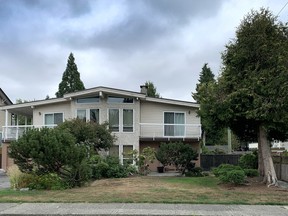The clause on the Burnaby property’s land title prevented the single-family home from being developed into multi-unit buildings, as allowed by the B.C.’s new housing legislation

The sellers and prospective buyer of a Burnaby home have successfully obtained a court order to cancel a decades-old clause on the property’s land title that would have prevented the single-family home from being developed into multi-unit buildings, as is permitted by the province’s new housing legislation.
B.C. Supreme Court records show the original developer of the subdivision came forward and gave his support for getting rid of the clause, but not before explaining why he inserted it in the first place: to prevent construction of hastily built homes that would “lower the perceived quality of the neighbourhood.”
Kenneth and Kathleen Pon owned and lived in their home at 3150 Chrisdale Ave. for four decades. They found a prospective buyer who was keen to convert it into a multi-unit building, according to court documents.
Four dwelling units would be allowed under the province’s new housing legislation and municipal bylaws that were amended in July 2024.
However, a clause or restrictive covenant on the land title, known as a statutory building scheme or SBS, put a snag on the sale. The clause, which was also attached to 18 neighbouring properties, prohibited the building of any dwelling on the property with first-floor space that was smaller than 1,400 square feet, unless permission was given by the builder. The prospective buyer of the Pons’ home didn’t want to proceed unless the clause was cancelled.
There was fear the builder, who had long gone out of business, would never be found. But court records show Douglas Day, who was the principal and sole director of De Courcy Developments, which developed the Burnaby subdivision of 19 properties in the 1970s, agreed to come forward.
In an affidavit filed in October, Day said that De Courcy initially owned all the lots, but sold them as vacant lots to buyers.
“In the early 1970s, the federal government introduced the Assisted Home Ownership Program, with the purpose of producing large quantities of modestly priced housing. I was aware that, as a result of AHOP, many small and hastily constructed rancher style homes were being built in developments across the Lower Mainland.”
He said he registered a clause in the land titles of all the properties to protect against these kinds of homes being built on the lots because it would “lower the perceived quality of the neighbourhood, which would then lower the value and sale price of the remaining unsold properties,” which De Courcy still owned.
He said he specifically “wanted buyers of the properties to construct large dwellings” and that this was why the restrictive covenants mandated a minimum square footage. He added that he never intended for the company to have indefinite control over the construction of the buildings and only sought to control what buildings could be erected until De Courcy sold all of its properties, which he said was a couple of years after the covenants were registered in 1975.
After serving the other homeowners and not hearing any opposition, the court ruled Oct. 29 to cancel the clause on the 3150 Chrisdale property, which the Land Title Office did on Nov. 15. The property remains listed for sale.
The province has said its new legislation doesn’t override restrictive covenants on land titles. Real estate and legal experts have said the province probably has the power to introduce some kind of legal mechanism to override restrictive covenants that are inconsistent with the new zoning bylaws, but it would require political will.

The Land Title and Survey Authority of B.C. gave a sense of the complexity of the issue when it previously said it isn’t possible to determine which covenants restrict the use of the land in a manner that goes against the intent of provincial legislation without reviewing each individual title. Understanding each one requires retrieving the land title and reading scanned documents, which include typewritten and handwritten notes, and include specifications on building height and floor space, or the number of domestic pets allowed.
The Housing and Municipal Affairs Ministry said in a statement this week that covenants on land titles were historically used for a variety of purposes, including limiting density.
“At this time, the province urges homeowners in this situation to seek legal advice regarding their options. The ministry will continue to monitor the implementation of small-scale multi unit housing across the province and evaluate any existing barriers that prevent more homes from being built for people.”
It added the province “is exploring a wide range of options and will prioritize what will have the greatest impact on reducing additional barriers (to increasing density) now that over 95 per cent of communities have local bylaws to make more of these homes possible.”